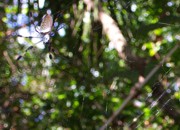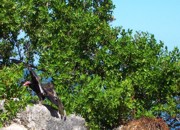At first glance this is a perfect project! 1.1 million dollars of Other People’s Money! Tourists screaming down a wire behind the galloping spiders and raccoons! 21 new full time jobs!
But wait. There’s more.
“A zip-line (also known as a flying fox, foofie slide, zip wire, aerial runway, aerial ropeslide, death slide, or tyrolean crossing) consists of a pulley suspended on a cable mounted on an incline… Zip-lines come in many forms, most often used as a means of entertainment. Longer and higher rides are often used as a means of accessing remote areas, such as a rainforest canopy. Zip-line tours are becoming popular vacation activities, found at outdoor adventure camps or upscale resorts…” 1
The Florida Keys Land Trust’s mission is to save the tropical woodlands called “hardwood hammocks” in the Florida Keys. The Trust purchased 63 acres at Crane Point to save the unique homestead from development, about five years after we moved to the Keys. I don’t think the two events were related. The tropical forest there is home to rare and endangered species, a series of unique archaeological and historical finds, as well as a large thatch palm hammock, a hardwood hammock, a mangrove forest, tidal lagoons, wetland ponds, and the associated animal life.
Unfortunately, money is tight and conservation doesn’t grow on trees.
 The Crane Point board wants to install six zip lines starting at the Cracker House and passing over the historic Adderley House and the Crane family’s 1959 home. Riders would zing over the butterfly meadows, the mangroves, and the Gulf of Mexico.
The Crane Point board wants to install six zip lines starting at the Cracker House and passing over the historic Adderley House and the Crane family’s 1959 home. Riders would zing over the butterfly meadows, the mangroves, and the Gulf of Mexico.
The Board asked the City of Marathon for a $735,000 state Community Development Block Grant and an additional $85,000 Tourist Development Council grant from the County.
 The Monroe County Commission last week found a “significant cost discrepancy and heard residents’ concerns” so they tabled the Tourist Development Council grant.
The Monroe County Commission last week found a “significant cost discrepancy and heard residents’ concerns” so they tabled the Tourist Development Council grant.
I’m in the “Let’s not zip over the Hammock” category but I’m also in the “Let’s Bring in Some More Visitor Dollars” category.
I reckon that zip lines do indeed fall outside the Crane Point mission of preserving one little sparkling piece of the natural Keys. And there is that nagging little question of scaring the spiders.
If Crane Point wants zip lines, let’s install them over to Survivor Island instead. We could start from 20th Street (which ends at the now defunct Boot Key bridge) or from Sombrero Country Club. Maybe both, to go downhill out to Boot Key from 20th Street, then back to the golf course. I could see zip lines criss-crossing Boot Key itself and then making the long run up the verdant length of the golf course to cross the Overseas Highway and terminate at the Crane Point parking lot. I volunteer to take the first ride!
Let the Land and Sea Trust install and run the thing as a profit center for Crane Point.
We’ll just need to be careful of the dangly bits going over Boot Key Harbor.
See, a saltwater crocodile jumped a Key Largo dock to snatch a 65-pound dog named Roxie last week. The owners heard Roxie bark once. Then they heard a splash. Witnesses who included Florida FWCC officers, estimated the saltwater croc to be at least 10 feet long. It sprang at least four feet out of the water to snatch the mutt headfirst off the seawall.
Oops.

Indeed, conservation does not grow on trees. That is a good line, and it reminds me of an incident.
A few years ago here in SE Tejas there was a conservation move afoot urging citizens to plant mini orange groves (meant to be interpreted as small groves of trees, not groves of small trees or of small oranges — even though the oranges are of a small variety).
Anyway, the idea was to make the fruit more plentiful in the local area, but it never really caught on. My neighbor Bob planted one in his yard, and ten years later it is producing fine fruit in greater abundance than he and his wife can consume. So, he loads up a small wagon and goes down the street giving them away to families with kids who like to suck on oranges.
Last Fall he gave a big bag to a Hispanic woman, and later he saw them in her garbage can by the curb. He was pissed and accosted her in her driveway.
“Food doesn’t grow on trees, you know.” He was heard to bark — just as she slammed the door and disappeared back inside her house.
— George